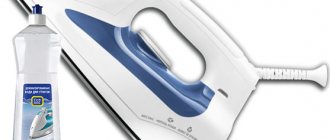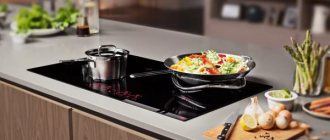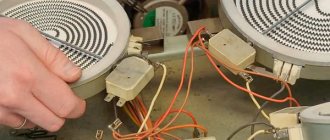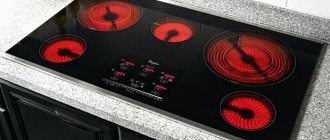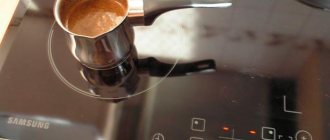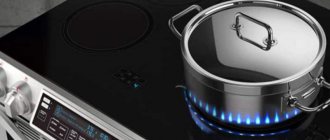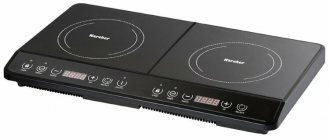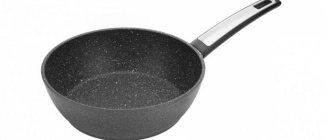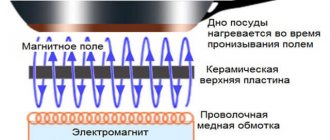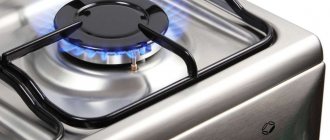Dishes are the main kitchen utensils of the housewife. The choice depends on many factors - the composition of the family, preferences in cooking and the features of the stove in the kitchen.
Standard gas stoves have been replaced by glass-ceramic hobs.
When visiting a store, a woman is puzzled by the variety of choices and, as a rule, wonders which cookware can be used on a glass-ceramic stove and which one is not worth looking at.
Glass-ceramic hobs, their capabilities and varieties
Glass ceramics is a relatively new material used in the production of cookers. Melting glass in a special way gives the surface a very beautiful appearance and special technical characteristics. Thanks to these properties, the hob is resistant to mechanical damage and tolerates temperature changes well.
Their design can complement any kitchen interior.
The glass-ceramic surface is very easy to care for; just wipe the surface with a cloth and a cleaning agent. Manufacturers do not recommend using cleaning products containing abrasives; it is better to purchase special compounds for such panels.
In addition to appearance, glass-ceramic hobs have a number of features and advantages.
Cookers with glass-ceramic surfaces are equipped with different types of heating elements: conventional pancake and double-circuit with an electric heating element, which allow you to adjust the heating diameter depending on the shape of the bottom of the pan. Also, this type of stove uses induction, which saves electrical energy.
The main feature of the stove is the vertical heating of the surface; all the heat is transferred to the dishes and is not wasted, which significantly saves the housewife’s time preparing dinners.
Those who have already purchased such equipment are wondering - what kind of cookware is suitable for a glass-ceramic stove?
It can be a built-in flat panel or complete with an oven of different volumes from 40 to 80 liters and a variety of functions that make it possible to grill in the oven. Cookers with mechanical adjustment or touch control panel, which is equipped with a variety of additional functions for ease of cooking.
The type of stoves with a glass-ceramic surface is classified as electric kitchen equipment.
What is a glass-ceramic surface and how does it differ from a regular stove?
The glass-ceramic stove is a household appliance that is a type of electric surface. It is made from a composite material based on glass and clay. The alloy is also called “ceran”. It conducts heat well, withstands heavy weight and heavy loads.
Despite its fragile appearance, the surface is strong and durable. The device is more economical than a standard electric stove because the material from which it is made distributes heat and cools faster. Only the bottom of the dish heats up, which makes it safe for humans.
Glass-ceramic and gas stoves have no similarities, both external and functional. They differ in the heat source, its distribution over the surface, the shape and size of the burners.
Modern panels are equipped with additional capabilities and sensors, which turns food preparation into a simple and safe process.
Convenient functions of modern glass-ceramic panels
- Thermostats. Allows you to maintain the set temperature and cooking time that are necessary for preparing dishes.
- Heating zone. The adjustment ensures uniform heating of the cookware depending on the size and shape of the bottom.
- Safety system. Eliminates the possibility of accidentally turning on the heating element by blocking it if little naughty creatures live in the house - this function is especially necessary.
- Automation. Significantly saves time on cooking. On the display you can select the cooking product, its weight and the optimal cooking temperature, the stove will beep when everything is ready.
- Boiling function. The stove automatically reduces the intensity of the heating element when the cookware reaches boiling temperature, this will protect the panel from “escaping” soup, and the housewife from washing the surface.
They differ from their electric counterparts in their perfectly smooth surface and external designation of the burners.
Manufacturers offer a wide selection of models that can be purchased depending on preferences: a number of burners with different heating elements, complete with an oven and a different set of functions.
The stove heats the bottom of the kitchen utensil, due to which the heat is subsequently evenly distributed throughout the entire container.
Features of glass-ceramic hob
The device operates on electricity without gas pipes. This makes it convenient and economical, allowing it to be placed anywhere in the room. The glass ceramic surface is smooth and perfectly flat. Heating zones are located in certain places, as indicated by contours of different diameters. Control is carried out using buttons on the touch panel.
The working elements of all electric models heat up instantly. The material of the glass-ceramic panel is ceran. It has high strength and the ability to withstand heavy objects. The burners on the panel can be of two types: halogen with heat-emitting lamps or High Light, heated by a ribbon made of a special alloy in the form of a snake.
The glass ceramic panel cools down as quickly as it heats up. It is safe to touch just a few minutes after switching off. For houses or apartments with frequent power outages, combined type models are suitable. There are electric and gas burners on the hob.
How to choose quality glass ceramic cookware
An electric stove with a ceramic coating is especially demanding when it comes to choosing suitable kitchen attributes; for all its reliability and excellent performance, incorrectly selected kitchen utensils can ruin the panel.
Upon completion of use, the surface of the panel cools quickly.
Many stove models are equipped with compatibility sensors; if you place unsuitable cookware on the surface, it simply will not heat up.
If you used a gas stove before purchasing a ceramic panel, then all kitchen utensils will have to be replaced. Glass ceramics require a perfectly flat bottom of pots and pans, and open fire, although slightly, deforms it.
Modern stove models can change the shape of the burners, which allows the consumer to use cookware of any shape.
When choosing, follow several recommendations:
- Buy products from trusted stores that sell products from major suppliers.
- Pay attention to the markings on the cookware; they should match the type of stove you have and the heating element installed there.
- Self-respecting manufacturers provide a guarantee for products of at least 24 months, this gives you confidence that this is a quality product.
The ideal bottom of the cookware should be smooth, without the slightest scratches or chips.
Tips for choosing
To select the right kitchen utensils, it is recommended to use a magnet, which should be placed on the bottom of the utensil when choosing. If it sticks, the container is suitable for use on an induction hob.
In addition to the above rule for an induction hob, other rules for choosing a suitable container are followed:
- Kitchen utensils must have a perfectly flat bottom. Concave, damaged shapes are not allowed.
- It is worth using kitchenware with a minimum bottom reflection coefficient. Thanks to this, the container heats up much faster, distribution occurs systematically. It is better to choose models with a dark or matte bottom. The glossy surface can reflect heat.
- The bottom must have a thickness of 3 mm. If it is thinner, the cookware runs the risk of becoming deformed during the cooking process. Models that are too thick take a long time to warm up.
- It is important to choose the correct bottom diameter. It must match the heating elements of the stove.
- When choosing aluminum containers, it is recommended to choose models with a painted or steel bottom.
- It is prohibited to use glass-ceramic containers on these stoves. In addition to the weak thermal conductivity of such an element, when using a plate and a container made of the same material together, the likelihood of scratching the surface increases.
Choosing kitchen utensils for a glass-ceramic panel is a labor-intensive and responsible task. But by choosing the right kitchen utensils, you can extend the life of the heating device. At the same time, food is prepared quickly, and energy consumption is rational.
Utensils according to the compatibility of the panel with the material of the utensil
When buying a new stove, housewives often change pots and pans, and wonder whether it is possible to put ceramic dishes on a ceramic stove?
You can set a certain heating power of the burner, and it will increase or decrease its power independently.
Depending on what heating elements your stove is equipped with, you need to choose cookware; now manufacturers put compatibility markings on their products, which will allow you to navigate the variety of types.
As a rule, cookware for classic stoves is more varied than for induction glass-ceramic models.
The main thing is that if you have a combination model, choose dishes that can be combined with different heating elements. The best choice would be metal cookware that is compatible with induction and electric heating.
When choosing a particular cookware, you should pay attention to the features of the production material, functionality and bottom thickness.
Which cookware is suitable for regular glass ceramics?
Glass-ceramic panels of this type are the most common, and the choice of cookware suitable for them is quite wide. On this stove it is recommended to use:
- enamel pans with a smooth bottom without chips or scratches;
- glass with heat-resistant properties;
- stainless steel;
- aluminum cookware with a Teflon or ceramic bottom coating.
It should be noted that when choosing utensils, it is better to take into account the properties of the materials: for example, glassware has low thermal conductivity.
The efficiency during cooking will not be too high, and energy consumption will increase. However, this fact cannot be considered a direct contraindication for the use of glassware.
Among the features of objects for glass ceramics, it is also worth mentioning the thickness of the bottom. The larger it is, the more evenly the food will be heated. In addition, the thick bottom protects the panel itself from excessive overheating.
Color also matters: a dark and matte bottom absorbs heat better than a light and shiny one.
As for the diameter of this part of the pot or frying pan, it is advisable if it exactly matches the diameter of the burner: this will reduce heat loss and make the panel work with maximum efficiency.
Types of cookware by materials for ceramic surfaces
- Stainless steel. Beautiful kitchen utensils that do not require special care, and the double bottom with which the dishes are equipped does not deform, which is important for a ceramic surface. It has excellent heat-conducting characteristics; stainless steel cookware is suitable for any heating elements.
- Aluminum. The product is very light, and thanks to the non-stick coating, you can cook any food on it without fear of burning. Ceramic dishes are used with a metal bottom and various coatings, it can be Teflon, ceramics or enamel. To be able to use it on induction, it is equipped with a special magnetic bottom; such cookware will cost a little more than its counterparts for conventional stoves.
- Cast iron. Ideal for all types of stoves, but it is heavy and the delicate ceramic coating can be scratched, so use a large cast iron cauldron for cooking pilaf with caution. But the high thermal conductivity of metal and its inability to deform go well with ceramics; dishes will be cooked as quickly as possible.
- Glass. It is acceptable to use glassware on electric heating elements, but it is not suitable for induction. If you love glass utensils and don’t want to give them up, purchase models with a built-in magnetic bottom. Glass has low thermal conductivity, and the metal bottom on the product will allow you to cook in a saucepan much faster, and it will also be induction compatible.
- Ceramics. Not a good choice for your stove. Some types of panels may simply not react to ceramics and not heat them up. If you love this material, then purchase metal copies with a ceramic coating, then it will fit any heating element.
- Enameled. Dishes that we have long been accustomed to and love to use. Every housewife will appreciate the beautiful design and safety when preparing and storing ready-made dishes in an enamel saucepan. It is perfect for your stove, but when purchasing, pay attention to the thickness of the bottom, it should be at least 3 mm; specimens with a thin bottom will quickly deform when heated quickly and will have to be abandoned from further use.
- Teflon. The cookware is made of metal alloys and coated with Teflon. Often Teflon models are made from aluminum, which is suitable for electric stoves, and induction heating elements will not heat them.
Suitable cookware material for glass-ceramic stoves is stainless steel with a double bottom, enameled or cast iron kitchen utensils, which are suitable for any model.
Soft metal products such as copper and brass are absolutely not suitable for use on a stove that is completely heated.
What to look for when choosing cookware for the hob?
We already have some ideas about the functions and properties of cookware for a glass-ceramic stove; the finishing touches remain. What is important to consider when choosing new utensils for your kitchen appliances?
Marking
It is not necessary to understand bowls in order to determine its properties, quality and suitability for a particular type of hob at the first glance at a pan. Manufacturers label their product for the convenience of customers. Therefore, the first thing we do is study the labeling. Usually this is a small diagram or icons applied directly to the dishes themselves. Here, information is schematically indicated about the possibility of cooking with this utensil on different surfaces, use in the dishwasher and microwave. The icon in the form of a circle with broken lines means that such cookware is suitable for glass-ceramic stoves.
Bottom and wall thickness
Thin, cheap saucepans will either quickly deteriorate on their own, or (even worse) damage the ceramic panel. Neither the bottom nor the walls should be thin!
- A stable bottom of the dish with a thickness of at least 0.7 cm. Ideal if it is multi-layered and moderately heavy. This way the heat will be distributed better and the pan will fit tightly.
- The walls are at least 5 mm thick. The food will taste better – fact! The pan retains heat longer and heats evenly.
Choosing heavy dishes is also not a very good decision. It is important to find a “golden mean”. Carrying heavy objects is inconvenient, harmful and dangerous for kitchen glass ceramics.
Diameter
If there is an induction coil inside your appliance, then the diameter of the frying pan and pot for cooking should not be less than 12 cm, in some models - up to 8. The device simply will not turn on and does not recognize the dishes. In other cases, it is important that the diameter of the bottom of the cookware and the burner match.
A convenient function in this case is the adjustment and autofocus of the burner. The stove “can” recognize the size of the bottom of the pan and adjust the heating zone to it. It’s reasonable to overpay for such a feature, because it allows you to rationally use electricity and not have to worry too much about selecting pots of the right size.
Material
If you look at it, there is nothing complicated in choosing a material. It is worth proceeding from the principle of heating the surface of a glass-ceramic stove. Stainless steel and cast iron are suitable for induction by default, the rest - only with a special bottom. Glass ceramics require a perfectly flat and even bottom with sufficient thickness.
To summarize, for a glass-ceramic surface, dishes made from:
- stainless or carbon steel;
- high-quality processed cast iron;
- enameled with steel bottom without coating;
- titanium;
- Teflon-coated aluminum, anodized aluminum.
Attention! Quality things don't have to cost exorbitant amounts of money. And if you approach your purchase responsibly and wisely, then cooking will not be a troublesome pleasure!
Other Compatibility
- Bottom. It should be thick, without reliefs or bulges with minimal reflection effect. If your stove has conventional heating elements that are not adjusted to different cookware diameters, then it would be better to purchase a set of kitchen accessories according to the size of the burners. On induction models, with a small bottom of the pan, less than 14 cm in diameter, it is recommended to use a special overlay on the burner, which ensures contact between the surfaces.
- Volume and size and wall thickness. It doesn't matter, the glass ceramic hob will heat any pan in no time.
- Type of lid and handle. The peculiarity of this stove is that it heats only the bottom, so which lid you choose is up to you; the handles are made of heat-resistant plastic, with the exception of cast iron cookware, which is not affected by any heating elements.
Since the principle of operation is aimed at interacting with the bottom of the vessels, their compatibility will directly depend on the bottom of the kitchen utensils.
Cookware compatibility issues
Just what kind of cookware cannot be used on a glass-ceramic stove. You will either need to buy a new one, with ferromagnetic properties, or look for a suitable container among your existing kitchen utensils.
For a glass-ceramic stove, you need to buy cookware with ferromagnetic properties.
Since the principle of operation is aimed at interacting with the bottom of the vessels, their compatibility will directly depend on the bottom of the kitchen utensils. You need to focus on it and evaluate it not only by its design and external features, but also by its characteristic features.
Characteristics of the “ideal” bottom
As mentioned earlier, the main criterion in selecting suitable cookware is the bottom. The ideal bottom of the cookware should be smooth, without the slightest scratches or chips. The presence of such defects can reduce the functionality of the equipment and damage its design.
The ideal bottom of the cookware should be smooth, without the slightest scratches or chips.
The thickness of the bottom should be moderate, at least a centimeter. After all, the thicker it is, the more evenly the container warms up. Plus, when buying a vessel, it is worth noting that the black matte bottom heats up better than the glossy and light one.
Stainless steel compatible
Stainless steel products have long been famous for their wear resistance and durability. They can be used not only on old gas stoves, but also on modern glass-ceramic stoves.
Such dishes are dense, layered, do not melt and leave no marks.
Such dishes are dense, layered, do not melt and do not leave marks. In addition, it is able to retain heat for a long period of time. The main thing is that there are no flaws on the case when purchasing.
Enameled and aluminum cookware
Kitchen utensils made of aluminum alloys are completely unsuitable for use on glass ceramics, at least that’s what many consumers say. However, modern manufacturers have begun to produce aluminum products with a specialized magnetic bottom, which allows the cookware to be fully used on such panels.
Modern manufacturers began to produce aluminum products with a specialized magnetic bottom.
Enameled objects also do not have high levels of strength in relation to mechanical stress. But, despite this factor, the metal does not oxidize when heated and does not release chemicals into food. Such dishes can be used on glass-ceramic stoves, but it is still recommended to pay attention to the bottom of the product.
Such dishes can be used on glass-ceramic stoves, but it is still recommended to pay attention to the bottom of the container.
Heat resistant glass
Glass cooking utensils are resistant to high temperatures. However, thermal conductivity indicators when operating on glass-ceramic equipment are very low.
Thermal conductivity indicators when operating on glass-ceramic equipment are very low.
Does it make sense to use such utensils on the stove? We think not. After all, in order to warm up the vessel, you will have to spend a lot of electricity. And as a result, the process of preparing one dish will become very expensive for you.
Ceramics and Teflon
Owners of such equipment often ask: is it possible to place ceramic dishes on a ceramic stove? Of course not! After all, dishes made from ceramics are popularly called earthenware, which means that magnetic properties are out of the question.
If you try to place a ceramic container on the surface of the panel, you will not get the result.
If you still try to place a ceramic product on the surface of the panel, you will not get the result. Either the pan will remain cold, or the stove will not react to its presence.
What are the features of heating dishes for glass-ceramic hobs?
A distinctive feature of such hobs is the rapid heating of the burners, which release thermal energy vertically only to the bottom of the cookware. And quick cooling of the surface will protect your family and especially small children from burns. If an induction heating element is installed on the stove, it does not heat the surface of the hob, but only interacts with the cookware. This is the safest stove on the household appliances market.
Modern manufacturers have begun to produce aluminum products with a specialized magnetic bottom, which allows the cookware to be fully used on such panels.
Features of heating dishes
Several spiral burners are built under the mirror-smooth body of the panel. When you turn on the stove, they heat up instantly and cool down just as quickly. The heat flow moves towards the hob evenly and in one direction, transferring heat to the bottom of the cookware.
There is no risk of getting burned when using such equipment.
There is no risk of getting burned when using this technique. This is due to the fact that the body is made of thick-layer material, and the operating principle is completely safe for humans.
What cookware should not be used on glass-ceramic surfaces?
When purchasing, you need to know: what cookware is suitable for a glass-ceramic stove and what absolutely cannot be used.
It is prohibited to purchase and use vessels made of fragile materials. Thin-walled products heat up quickly and there is a risk that they will melt.
Characteristics of kitchen utensils that are unacceptable for glass ceramics.
- Dirty and rusty bottom surface, which will stain and scratch the glass ceramics. Stains can still be dealt with, but scratches are a violation of the integrity of the surface on which cracks may appear.
- Pure soft alloys without non-stick coating, aluminum and copper frying pans or pans, when heated, interact with the surface and leave stains on it that cannot be removed with anything and your hob will lose its beautiful appearance forever.
- Kitchen utensils with deformed or embossed bottoms and items with engravings on the bottom. The surface should be as smooth as possible, matte or dark in color, then you will ensure better interaction between the hob and cookware, which will significantly save energy and time on cooking.
- The walls of kitchen utensils that expand upward, for example, a wok, are unacceptable. A small bottom, in relation to the area and volume of the entire surface of the pan, will not heat the food.
Modern stove models are distinguished by high power and heat transfer.
Types and nuances of hobs
Standardly, there are two types of panels and free-standing slabs:
- gas. Gas from a cylinder or central pipe enters the burner, which, when ignited, produces a uniform flame;
- electric. They operate from the mains, do not require gas, and there is no open flame.
Gas panel
Electric panel
In the production of the latter, materials ranging from steel to glass are used; the heating principle of the burners can be completely different. But we are interested in glass ceramics. This is a coating for an electric hob with special operational and aesthetic properties (it has the technological name “ceran”). This panel is durable and beautiful, its smooth surface is good for a holistic image of a modern kitchen. But the principle of heating the burners may differ:
- induction;
- electricity (for example, hi-light, rapid and halogen burners).
This parameter affects the choice of cookware for a glass-ceramic stove.
Electric hob/stove
We all remember the old electric stove with large “pancakes” instead of gas burners. Now the work surface looks much more aesthetically pleasing. Burners of different diameters are hidden under a flat, glossy mirror. Only the outlined zone is heated, and the rest of the glass-ceramic sheet remains cool.
Principles of coil heating:
- hi-light or strip burners are heated using special high-tension strips twisted into a spiral. Fast heating, high temperatures and operational reliability make highlight tiles market leaders in this category;
- halogen. A burner in the form of a hollow spiral filled with gas. Heating is instant, you can adjust the diameter of the heated surface. However, the service life of halogen technology is comparatively shorter;
- Rapid burners are also spiral-shaped. High temperatures and heating rates ensure almost instant readiness for use.
Induction
This panel also operates from the mains, but heating occurs due to the magnetic properties of the cookware and the generator in the stove body. The energy of the magnetic field heats only the bottom, while the surface itself remains cold or barely warm. This is very convenient, but if the hob is both induction and glass-ceramic, the requirements for cookware double. Such a plate is in contact only with the ferromagnetic bottom. Or you’ll have to buy a special adapter if it’s a shame to throw away old, but quite decent saucepans.
Induction hob
What problems can arise if you choose the wrong kitchen attributes for an electrical panel?
First of all, due to the rapid heating of the surface, the bottom of unsuitable dishes quickly becomes deformed, and this threatens you with throwing out your favorite saucepan and overheating the heating element. Repairing such equipment is a very expensive procedure. When using soft alloys, you will forever leave sloppy stains on the surface that cannot be removed. Due to the use of very heavy and massive kitchen utensils, the likelihood of cracks and chips in the coating increases; you can use such stoves, but they will not last you long.
Using existing or purchased steel or cast iron cookware, you definitely won’t go wrong and won’t damage the glass-ceramic hob.
Hob types
Depending on the connection method, hobs can be autonomous or dependent on the heating element. All glass-ceramic models have high, easily adjustable thermal conductivity. The following types of hob surfaces are most commonly used:
- Electrical. They stand out for their huge functionality. When choosing such a model, you should take into account the large load on the electrical wiring. It must withstand high voltage. The hob is completely covered with a glass-ceramic hob. The burners are round or oval.
- Induction. Modern simple devices that are gradually replacing other types of surfaces. Practical, durable models equipped with advanced features. Economical equipment instantly heats the burner and automatically turns off if there are no containers on it.
- Gas. Reliable plates are able to work in the most extreme conditions. Modern glass-ceramic coating can withstand the effects of combustion and high temperatures on a par with metal surfaces.
Useful tips for the care and use of glass ceramic cookware
In order for your cookware to prepare tasty and healthy dishes and to please you with its appearance, you need to take proper care of it.
A black matte bottom heats up better than a glossy and light one.
A few tips that may be useful to the hostess.
- When purchasing new dishes, they must be thoroughly washed with a mild detergent and dried before use.
- Keep kitchen utensils clean, this is especially important for glass-ceramic cooktops.
- Do not use abrasive cleaners that will scratch the surface. Products with a non-stick coating are especially sensitive to abrasives; scratches form on the surface, and such cookware can no longer be used for cooking. The stainless steel pan will become dull and lose its shiny surface.
- When cleaning surfaces, it is better to use folk care products. Baking soda and mustard powder, which are also suitable for your hob, are excellent for cleaning almost all contaminants.
- Do not leave empty dishes on the stove; overheating is dangerous not only for your saucepan, but also for the stove. It is advisable that the pan be filled with food to 2/3 of its volume.
- Avoid placing a wet bottom of a pot or pan on a hot burner; ceramics are a resistant coating, but such contact may cause microcracks to form, which reduce the life of the hob.
Some modern models simply do not turn on when there are inappropriate dishes on their surface. These include: glass, aluminum, brass objects.
By choosing the right kitchen accessories in the store, you will use your favorite saucepans for a long time and will not damage the beautiful surface of the glass-ceramic panel.
Before purchasing a glass-ceramic vessel, read useful information in online resources or consult with the seller before purchasing.
Some more tips on choosing cookware for glass ceramics (including induction hobs)
Whatever glass-ceramic hob you have - induction or standard, you need to use it carefully so as not to accidentally drop utensils on it or scratch it when moving it from place to place. Therefore, when choosing your frying pans, pots, cauldrons, cauldrons and stewpans, remember the following recommendations:
- All fastenings on the handles of dishes must be reliable, ideally screwed and not welded.
- It is advisable that the handles of the utensils have protection from heat to reduce the risk of burns to a minimum.
- Also, containers must have stable and suitable-sized lids.
- If you are about to buy a new hob, but because of your favorite cookware collection you are still unsure which stove to choose, then we advise you to think about combination stoves with conventional and induction heating zones.
Support the project - share the material with your friends on social networks:
Which pan is better to choose?
The quality of the dish and the ease of its preparation depend on properly selected kitchen utensils. The pan is one of the actively used items, so it should have increased wear resistance. It is important to consider the material from which the manufacturer made it, the presence of handles and a lid. Among the criteria for finding out which pans are the best is the type of cooking surface. The cookware that is suitable for one type of stove is incompatible with the second, but store consultants are silent about this. The following types of plates are distinguished:
- gas;
- electric;
- induction
What pots are best to buy for a gas stove?
Gas-heated stoves are considered the most common due to their ease of connection and low cost compared to other models. This explains why it is easiest to find cookware for them, because almost all fireproof varieties are suitable. In this case, you don’t need special knowledge to understand how to choose pans for a kitchen with gas cooking. For her, the best solution would be the following types of dishes:
- Cast iron. The iron alloy for this cookware combines with carbon, silicon and phosphorus at a temperature of 1400 degrees, so the pan will withstand hours of simmering berries and fruits or thick soups.
- Glass or made of hardened ceramic. So that you don’t have to take risks when deciding how to choose a pan that can split when heated on a gas fire, you need to purchase a divider for it.
- Enameled. A metal pan is coated with enamel by pouring, which protects food from contact with steel and oxidative reactions.
How to choose pans for an induction cooker?
The process of choosing cookware for a stove heated by a strong magnetic field can be considered an exciting experience. You won’t have to guess which pans are best for an induction stove if you take a magnet with you to the store. You need to attach it to any copy you like to make sure that the dishes can be purchased. If the magnet sticks to the bottom of the pan, it is allowed to be used. In this way you can make sure that aluminum, glass and ceramics are absolutely not suitable. The list of materials recommended for the pan includes:
- stainless steel;
- cast iron;
- aluminum with ferromagnetic coating.
Which pans are suitable for electric stoves?
The surface of an electric heating plate can easily be damaged by heavy elements of the pan with edges sharpened or deformed during production. Therefore, in response to the question of which pans are best to buy for an electric stove, experts recommend paying attention to cast rather than stamped cookware. It is better if it meets two more criteria:
- The optimal wall thickness should be 5-6 mm. As much as you might want to choose a pan that is light in weight, it will heat up too quickly and the contents will burn or form a high foam.
- The diameter of the bottom must correspond to the circumference of the burner. If the bottom is larger or smaller than the heating element, the food will cook slowly and will be dry rather than juicy.
What material is better for pans?
The question of the superiority of one material for utensils over others is philosophical. In order to understand how to choose a good saucepan from quality material, you need to soberly assess the frequency of future use, financial capabilities and the number of family members. Traditionally reliable materials for pans often used in cooking and stewing include:
- stainless steel;
- aluminum;
- ceramics;
- fireproof glass;
- Teflon;
- cast iron.
Aluminum pans
Aluminum cookware was considered the most common in the Soviet Union because it was cheap and easy to clean. This material quickly conducts heat, which saves gas and electricity, and is practically not subject to corrosion. Cast aluminum pans, when in contact with fruit and lactic acids, introduce toxins into food, if you do not choose it taking into account the following recommendations:
- Safe covering. Stone or iron alloys prevent aluminum from releasing poisons into the food being cooked.
- Short-term storage in containers. The process of metal reaction with food occurs during prolonged contact, so after cooking is completed, the food must be transferred to another container.
- Cleaning with mild products. Aggressive chemicals damage the tightness of the pan coating.
Ceramic pots
Any kitchen utensil made from this material is supported by its absolute environmental friendliness and safety for humans. Ceramics do not emit any impurities or odors, so you don’t have to decide which pans are better - with or without coating. It is resistant to frequent use, mechanical damage and abrasion. True, ceramics also have their drawbacks:
- Fragility. This is the main flaw: no matter how you try to choose a durable pan, it will still break if it falls on the floor. For the same reason, strong impacts leave chips on the material.
- Slow warm-up. There is no point in boiling eggs or sausages in ceramic cookware because the process will take too long due to the thick walls of the container.
Stone coated saucepan
The dishes can be made entirely of stone or covered with a layer of stone chips. The stone does not contain perfothorakinic acid, which is found in artificial materials and tends to accumulate in the liver and kidneys. Anyone who knows how to choose the right stone-lined pan will advise you to pay attention to the following aspects:
- The need to use oil for extinguishing.
High-quality stone cookware provides the advantage of simmering and frying dishes without adding fat. - Washing method.
The denser the layer of stone chips, the less means are required to remove dirt from the surface of the walls and the day. The highest quality specimens can be wiped with a clean cloth. - Wear resistance.
The packaging of the cookware must indicate that it can withstand at least 50,000 scratches.
Glass pots
The unusual appearance of transparent glass pans scares off many housewives who refuse them due to their apparent fragility and impracticality. The material used for them is durable fire-resistant glass, which does not crack even when dropped. A pan made of heat-resistant glass does not impart any foreign tastes or odors to the food being cooked in it. The main criteria for choosing reliable cookware should be:
- presence of a cover;
- thick walls and bottom;
- resistance to sudden temperature changes.
Titanium coated pan
The main feature of titanium coating is its exceptional resistance to damage and everyday wear. Titanium is not applied by spraying, but is fused into the metal, so it cannot be erased when cleaning with a sponge and abrasive powders. You can find out which pans are best to buy by asking the seller about such features of a particular model as:
- The presence of an anti-corrosion coating that will help protect the dishes from darkening stains and cracks.
- Safety of using metal cutlery. Sometimes, when faced with searching for an answer to the question of how to choose a pan, the buyer finds out that the titanium layer is too thin and, despite its apparent strength, can be damaged by a metal spatula or ladle.
How to choose a stainless steel pan
The range of stainless steel pots can be called meager in terms of color and design compared to the variety of designs of other options. From the point of view of practical application, and not appearance, you won’t have to think long about which pans are the best: stainless steel is the only material that is not afraid of chipping and burning. Tips for choosing stainless steel cookware are as follows:
- It is better to purchase household utensils in specialized stores, otherwise you may run into a fake made from another alloy that does not guarantee such properties.
- Do not focus on a low price, because stainless steel simply cannot be cheap.
- To ensure uniform and rapid heating, the lid must fit tightly to the rim of the pan - this must be checked immediately before purchasing the selected model.
Cast iron pans with enamel coating
Utensils made of cast iron are similar in properties to utensils made of stone, but only if they do not have an enamel coating. To understand how to choose an enamel pan with a layer of enamel, and not with a fake coating, you only need to look at the inside of the pan. It should have a glossy black, white or colored finish without roughness or sagging. There should not be a single chip on it - this is a direct indication that heating is prohibited.
Hob care
A stove with a glass-ceramic panel requires specific care. In order for it to remain in good condition for as long as possible and to please you with cleanliness during operation, you need to listen to the following advice:
- Do not place wet dishes on the glass-ceramic surface. Heating a pan with a wet bottom will cause white spots to appear. It will be very difficult to get rid of such divorces.
- Do not use a dish sponge for cleaning. Residues of fat and food particles can leave scratches and other damage. This should be a separate thick cloth intended exclusively for wiping the fragile panel.
- Do not allow sugar or plastic to come into contact with the surface. When heated, substances will begin to melt and eat into the surface.
- Any contamination from the induction type surface must be removed immediately. Dried dirt can be removed with a special household scraper. You can replace it with a regular razor or a melamine sponge.
- For difficult stains, use only mild products. The glass-ceramic surface can only be cleaned using a gentle method. Hard metal scourers and abrasives should not be used. The stains must be covered with baking soda, covered with a damp cloth, and left for 10 minutes.
- Creation of a protective thin film. The desired screen film will be obtained if you wipe the clean surface with a napkin soaked in vegetable oil. Dust, small particles of paper napkins, and crumbs will not settle on such a stove.
Cookware for induction cookers
Please note that sometimes manufacturers are disingenuous by marking pots and pans with an induction symbol. Before going to the store for new dishes, we recommend purchasing a magnet. With its help you can check the properties of the bottom. If the magnet is attracted to the surface, the cookware is suitable for use on an induction hob.
It is advisable to buy a saucepan (frying pan) with a bottom diameter of at least 8 centimeters, otherwise the coil may not turn on.
The best material for an induction hob is stainless steel.
Basic requirements for dishes
Hob manufacturers recommend using metal pots and pans that meet all requirements. The cookware must have a flat, even bottom to ensure the best heat transfer. If the bottom of the item is deformed, the burner itself will overheat, which will shorten its service life. Even small air gaps between the surface and bottom of the cookware reduce heat transfer. There should be no embossed manufacturer's marks, relief patterns, or other roughness.
The bottom of the dish must have a minimum reflection coefficient. Matte dark surfaces are preferable. It must be dense enough to prevent deformation under the influence of high temperature. If the thickness of the bottom is not enough, there is a high probability of sagging, which will lead to a decrease in the tightness of the bottom to the surface of the electric stove.
To avoid overheating, the cookware and burner must be the same diameter. Heat is dissipated very poorly from the uncovered part of the element. If the edges of the bottom of the pan extend beyond the burner, there will not be enough power for full heating.
Manufacturers of stoves and glass-ceramic surfaces recommend using pots and pans with concave bottoms. This design will ensure a tight fit and efficient use of heat.

